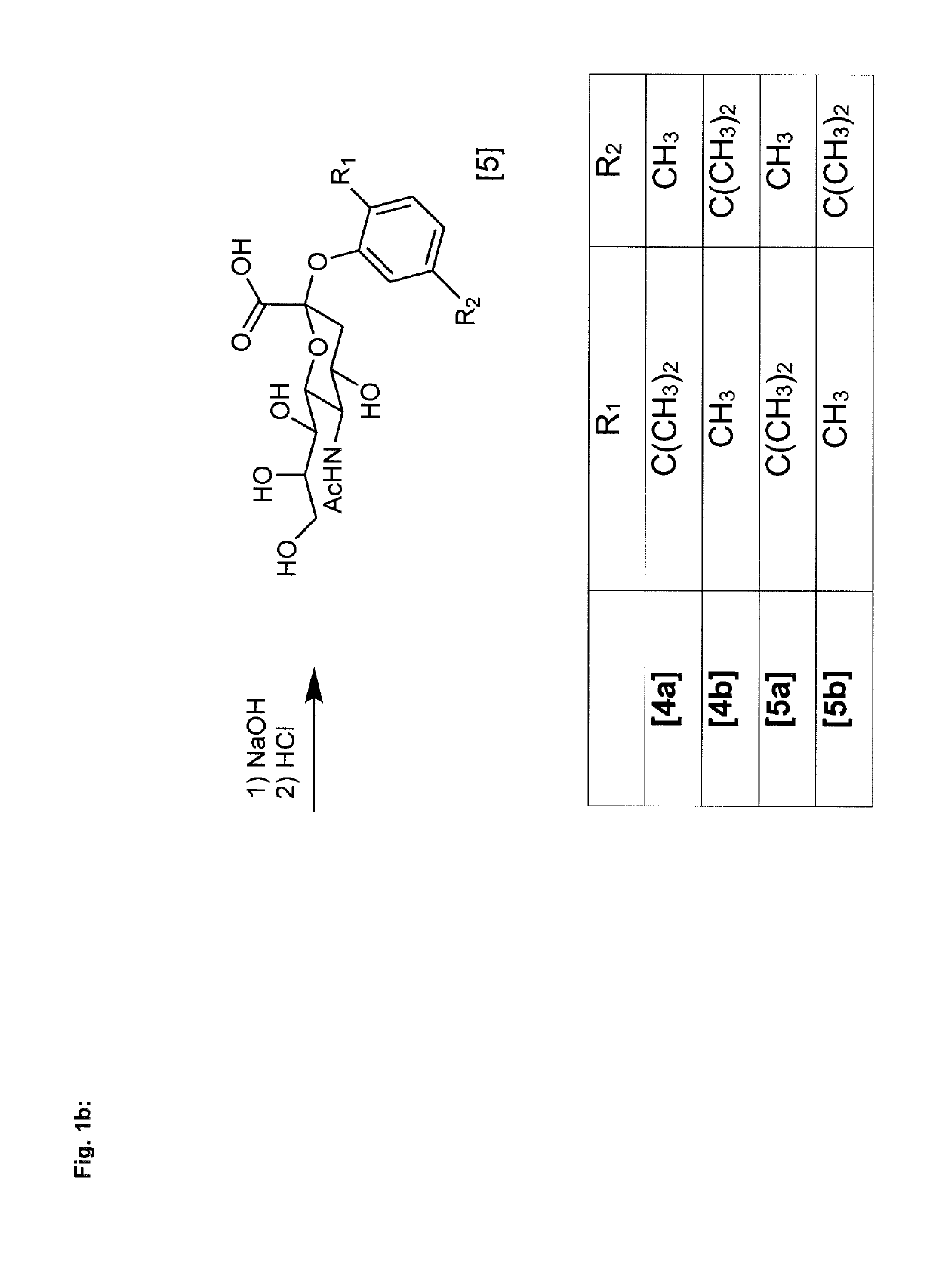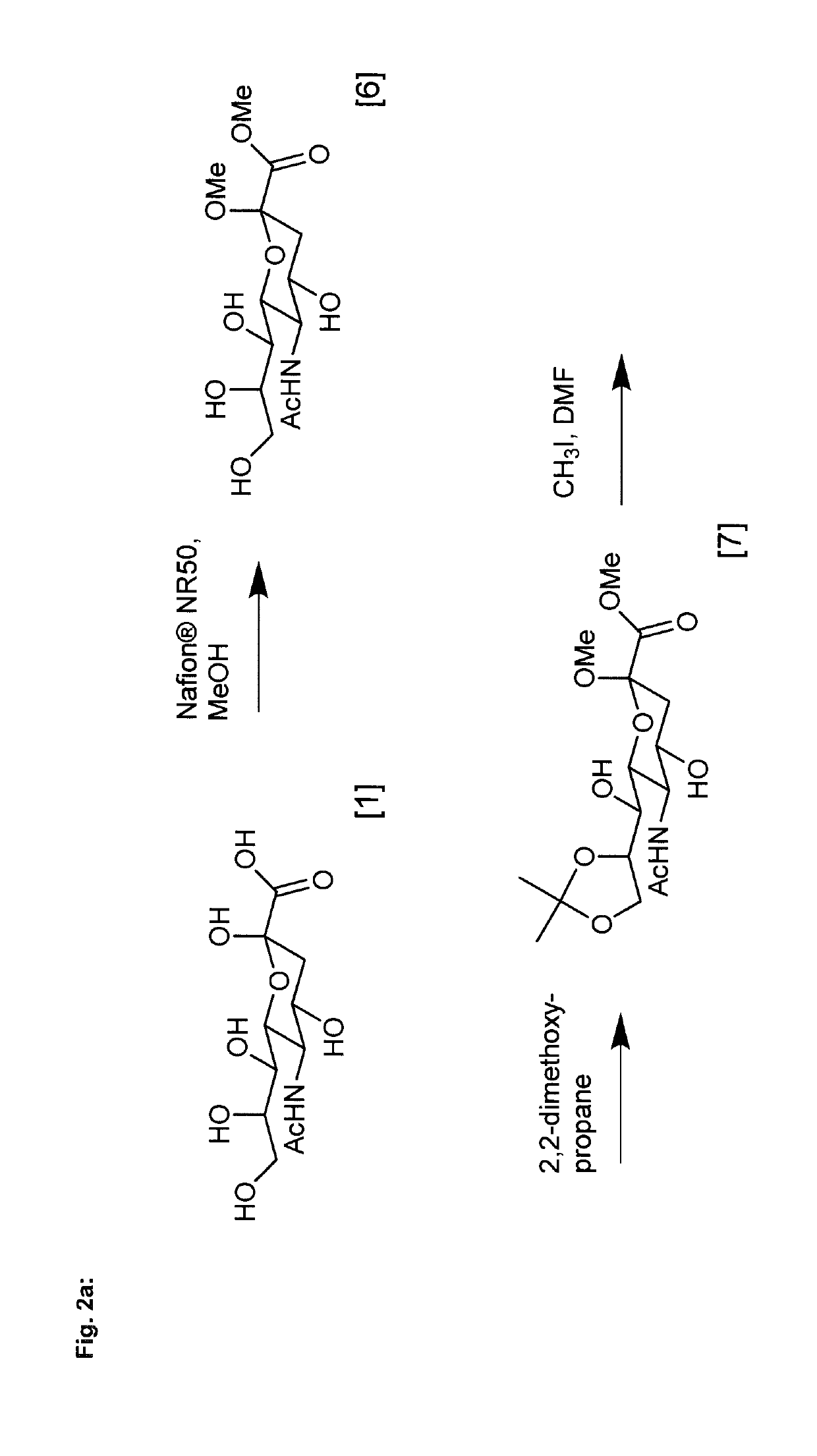Diagnostic sensor and chewing gum comprising such a diagnostic sensor for the taste-based detection of viruses
a technology of diagnostic sensor and chewing gum, which is applied in the direction of compound screening/testing, biochemistry apparatus and processes, medical preparations, etc., can solve the problems of difficult to correctly diagnose the disease, virulence and intensity of symptoms are often and rapidly changing, and the morbidity rate is often even higher. , to achieve the effect of reducing the prescription of antibiotics and facilitating self-diagnosis
- Summary
- Abstract
- Description
- Claims
- Application Information
AI Technical Summary
Benefits of technology
Problems solved by technology
Method used
Image
Examples
example 1
of Neu5Ac-methyl ester [2]
[0055]1.563 g of Neu5Ac [1] (CarboSynth) are dispersed in 50 ml of anhydrous methanol. 2 g of Dowex 50 W×2 (washed with dry methanol) are added and the batch is stirred at room temperature for 5 hours. Thereafter, the ion exchanger is filtered off and washed several times with methanol. After having removed the methanol by distillation product [2] is purified with silica gel (eluent:methanol) to obtain 1.354 g (83%) of [2].
example 2
of Neu5Ac-thymol [5a]
[0056]Acetyl chloride (10 ml) is added to a solution of the methyl ester of Neu5Ac [2] (603 mg, 1.95 mmol) in acetic acid (10 ml) and the batch is left sealed at room temperature for 18 hrs under stirring. Subsequently, the solution is evaporated under vacuum and dried by adding toluene to obtain [3] as a white residue. The product is used without further purification due to the instability of the chloride.
[0057]A solution of thymol (510 mg, 3.40 mmol) in dimethylformamide (DMF) (10 ml) is slowly added dropwise to a suspension of NaH (60% in mineral oil, 82 mg, 3.429 mmol) in tetrahydrofurane (THF) at 0° C. and the reaction mixture is stirred for 10 min. To the blend is added the solution of the chloride [3] in THF within 15 minutes. After complete addition the mixture is stirred for 19 hours at room temperature. Thereafter, the mixture is diluted with 40 ml of ethyl acetate and transferred to a separatory funnel. Now, the organic phase is washed with water (2×3...
example 3
of 4,7-di-O-methyl-Neu5Ac-thymol [12a]
[0059]Acetyl chloride (3 ml) is added to a solution of the methyl ester of 4,7-di-O-methyl-Neu5Ac [9a] (33 mg, 0.094 mmol) in acetic acid (3 ml) and the batch is left sealed at room temperature for 18 hrs under stirring. Subsequently, the solution is evaporated under vacuum and dried by adding toluene to obtain [3] as a white residue. The product is used without any further purification due to the instability of the chloride.
[0060]The beta-silyl chloride [10a] is dissolved in 10 ml of anhydrous DCM. In a further flask, 586 mg of thymol (3.9 mmol), 95 mg of silver carbonate (0.345 mmol), and 300 mg of molecular sieve 4 Å are dissolved in 10 ml anhydrous DCM in the absence of light and oxygen. The first solution with the educt is slowly added to the second one and stirred for 72 h at room temperature.
[0061]Thereafter, the mixture is diluted with 40 ml of ethyl acetate and transferred to a separatory funnel. Now, the organic phase is washed with wa...
PUM
| Property | Measurement | Unit |
|---|---|---|
| optically active | aaaaa | aaaaa |
| optical perception | aaaaa | aaaaa |
| structure | aaaaa | aaaaa |
Abstract
Description
Claims
Application Information
 Login to View More
Login to View More - R&D
- Intellectual Property
- Life Sciences
- Materials
- Tech Scout
- Unparalleled Data Quality
- Higher Quality Content
- 60% Fewer Hallucinations
Browse by: Latest US Patents, China's latest patents, Technical Efficacy Thesaurus, Application Domain, Technology Topic, Popular Technical Reports.
© 2025 PatSnap. All rights reserved.Legal|Privacy policy|Modern Slavery Act Transparency Statement|Sitemap|About US| Contact US: help@patsnap.com



